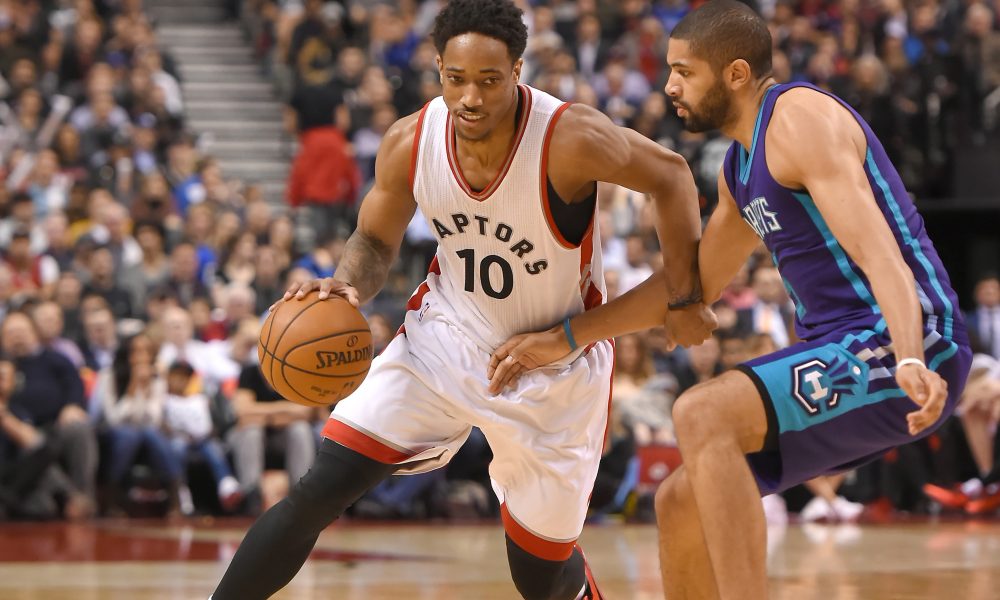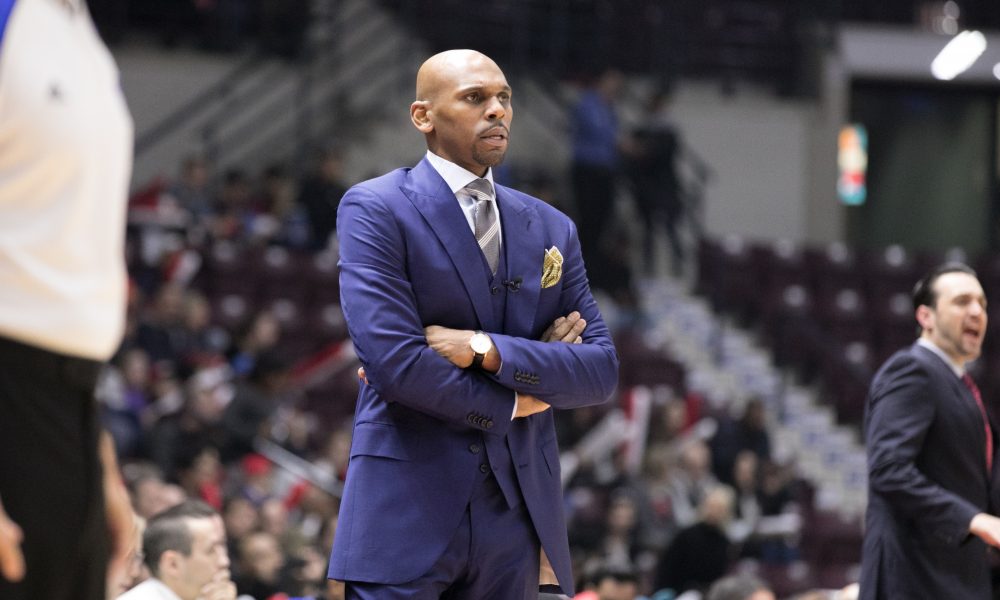If you haven’t yet done so, I urge you to read William Lou’s piece on Medium tackling Toronto’s Jonas Valanciunas issue. Even if you don’t agree with his conclusions (spoiler alert: I don’t), Will is a necessary read when he dives deep into the Raptors. The issue of JV is a polarizing one in the Raptors community, and it tends to divide fans into two sides that are on opposite ends of the spectrum. Since Will provided a well-reasoned take from his side of the spectrum, I thought it only fair that I do the same for my side. There were a few criticisms that I wanted to rebut, namely the idea that Valanciunas hasn’t grown in his years in the league, and the idea that a player like him is becoming obsolete in the “modern” NBA, and unplayable in high leverage situations.
To understand JV’s growth with the Raptors, it’s first essential to understand his role with the team. Although he was the team’s hope for the future when they drafted him at #5, luck and the brilliance of Masai Ujiri meant the Raptors became a really good team in his second season. This meant that, unlike other young players who got the blessing and the curse of all the possessions they could handle on putrid teams, Valanciunas was expected to play a heavily regimented role that would help the team win games. It’s within that role that his growth has come.
One of the main criticisms of JV’s game has been his lack of passing ability. And it’s true that he hasn’t flashed the sort of vision that his idol, Arvydas Sabonis had in his brief years playing in the NBA. But that’s largely by design. Before this season, Casey’s management of his offense was largely laissez-faire. Although Nick Nurse garnered deserved praise for the breadth and depth of his playbook, Casey was willing to let his two stars dictate the offense for the majority of the game. And since those two stars are score-first players, that meant that everyone else on the team took on a complementary role. As we saw in the playoffs the last 4 seasons, that approach didn’t work. In fact, there’s evidence that it seemed to stifle the creative tendencies of those complementary players. Luis Scola, James Johnson, DeMarre Carroll, Amir Johnson, Terrence Ross, even Bismack Biyombo – these are players who saw their Assist% jump when they left the Raptors and Casey’s (lack of an) offense.
In fairness to Casey, he’s done a much better job this season of instituting more motion and more involvement for complementary players in the offense. And, lo and behold, it’s served to help Valanciunas’ passing as well. His current Assist% is the highest of his career, and second highest among rotation big men on the team, ahead of Poeltl, Lucas Nogueira, and (of course) Serge Ibaka. With this information, combined with his blossoming into one of the best rebounders in the NBA (top 8 in Rebound% the past 3 seasons), a premier roll man (83.3rd percentile on the roll this season, 92.2nd percentile last season, and 90th percentile in 2015-16), as well as the fact that he’s become a reliable midrange shooter, it would be fair to say that JV has shown growth within the role prescribed to him by the organization.
You might note that all of that growth (save rebounding) that I mentioned was on the offensive end. And it’s obviously true that Valanciunas isn’t a great (or even good) defender. That largely leads into my second issue, the idea that Valanciunas is obsolete in the modern NBA. I think this idea is pure bunk, honestly. There will always be room in the NBA for big men who can draw scads of attention when they roll to the basket, finish at the rim at an elite rate, and rebound the hell out of the ball. Valanciunas does all of those things, and we’ve seen that it’s possible to build good defensive lineups with him on the court as well. That’s because Valanciunas is actually a pretty good rim protector, and when he’s placed in a conservative scheme, with a smart, quick big man next to him, the Raptors have experienced their greatest success. As sexy as it may be to say that the big man is going extinct in the NBA, the simple truth is that a large part of Toronto’s success over the last 4 years has come because of, not in spite of, having Valanciunas in the lineup.
According to NBA.com, 12 5-man lineups played more than 50 total minutes for the Raptors last season. Of those 12, 8 lineups had positive net ratings. And of those 8, 6 included Jonas Valanciunas, including the 4 best lineups, and 6 of the top 7. This trend was present in 2015-16 as well. Out of 15 lineups with greater than 50 minutes played, 8 had positive net ratings, and the 3 best lineups all had Valanciunas at center. Simply put, JV is more than just a role player for the Raptors. In fact, he seems to be one of the keys to maximizing the team’s potential, and although it’s true that he’s struggled at times this season, it might surprise some to learn that, if you relax the requirements from 50 to 20 minutes this season, the best lineup that the Raptors have put on the court, by net rating, has included Valanciunas, albeit in a ludicrously small sample size.
This disconnect between what we expect and what actually happens brings me to my last point: the misconception that JV going to the bench in the Milwaukee series won the Raptors the series because of addition by subtraction; namely, that the Raptors won because JV was no longer on the court and messing everything up for the other players. Nothing could be further from the truth.
It’s important to realize that in that Milwaukee series, outside of Giannis Antetokounmpo, Milwaukee’s obvious superstar, the best Buck came off the bench, in the form of Greg Monroe, and in the first 3 games, Monroe ran roughshod over the Raptors, largely because their bench bigs weren’t strong enough to stop him. Even though it may not have been his intention, when Casey brought Valanciunas off the bench starting in game 4, he matched up his best post defender and rebounder with Milwaukee’s best post scorer and rebounder, and essentially stymied him for the rest of the series. It’s somehow become commonplace to talk about the latter half of that series as though Valanciunas played no part. In fact, in the pivotal game 4, when the Raptors were battling back to tie the series after getting blown out in game 3, the center that was on the court to close out the 4th quarter was not Ibaka, but Valanciunas. And in game 5, Ibaka didn’t come into the 4th quarter until there were 5 minutes left and the Raptors were up by 18 points. Make no mistake, JV played a pivotal role in winning that series.
I don’t say all of that to say that Valanciunas has been blameless this season. He’s been extremely inconsistent, and it seems clearer and cleared that he isn’t a good fit with Ibaka, and more worryingly, DeRozan, and considering his contract status and his hierarchy with the team, that makes him the most obvious candidate to be shipped out in a trade. And honestly, I’d be fine with that. As a fan of JV the person and the player, I’d like to see him in a new market, partially because I want to see him spread his wings, and partially because the daily debate about his value to the Raptors is getting torturous. But from a strict asset management standpoint, unless an unforeseen suitor for Valanciunas becomes available, it makes sense for the Raptors to hang onto him and use him to maximize the effectiveness of the team. After all, the team has looked its best over the past few years when Valanciunas has been an involved and engaged member of the offense and defense. And considering that Joel Embiid, the best post scorer in the NBA, looks like the newest scary threat in the Eastern Conference, having an expert post defender could be useful.



